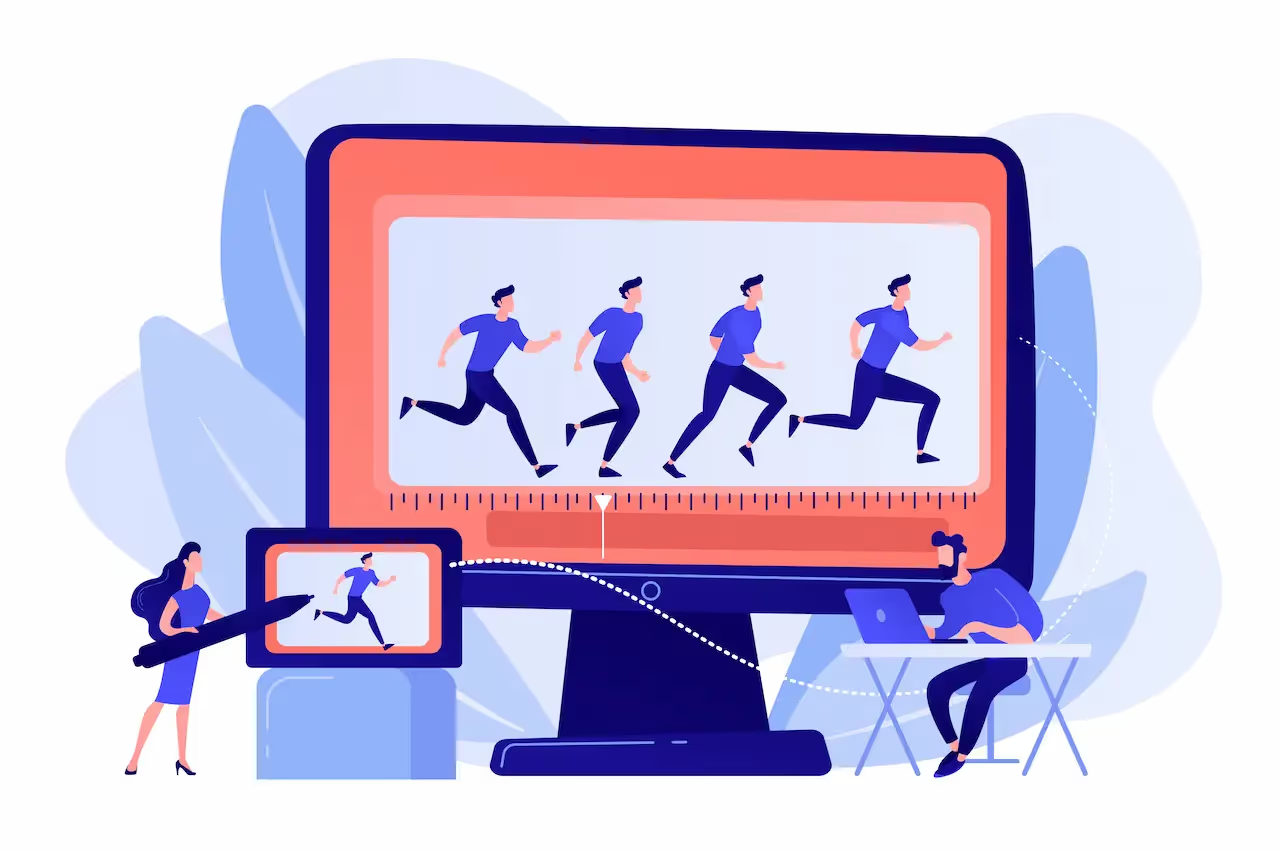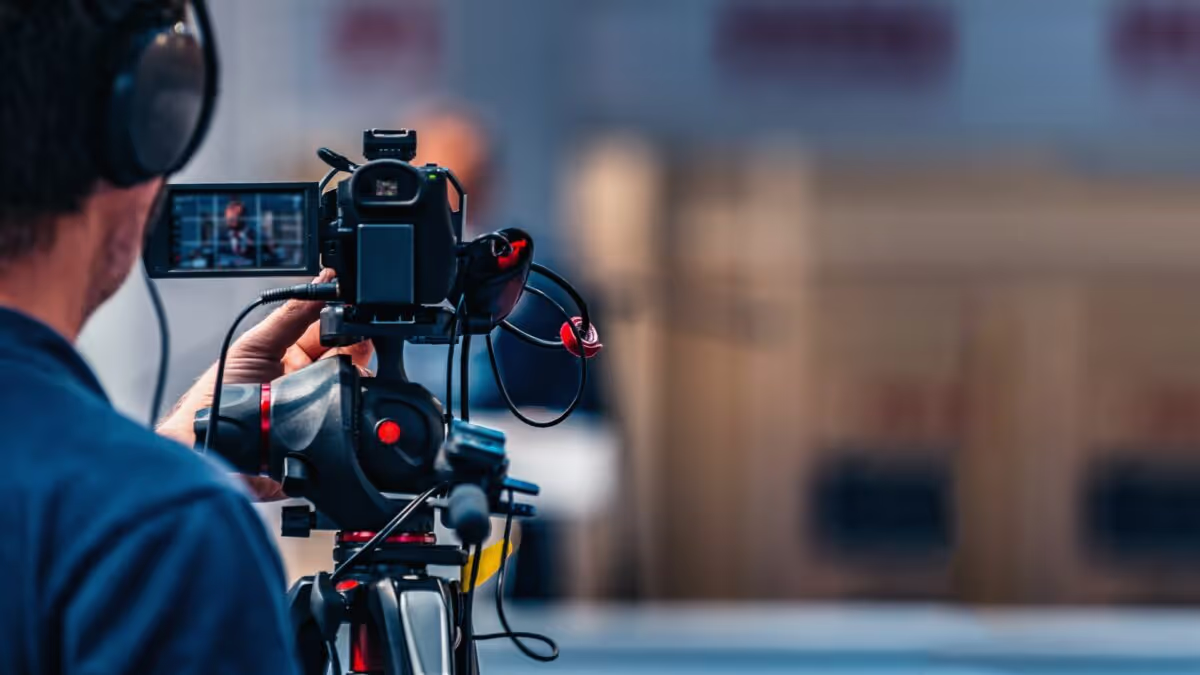Table of Contents
Corporate motion graphics have become a practical and creative way to improve business videos. Instead of relying only on talking heads or live footage, motion graphics add visual structure, highlight key points, and keep the viewer’s attention. They help simplify complex information and make branding more consistent across different types of video content. Whether you are creating an internal training video, a company update, or a product explainer, well-designed motion graphics can add clarity and professionalism.
At Get Camera Crew, we support corporate producers and marketing teams by offering in-house motion design alongside live-action production. This makes it easier to plan, create, and deliver polished corporate videos that stand out.
Key Benefits of Corporate Motion Graphics
Motion graphics are one of the most useful tools in modern video production for businesses. Here are some of the key benefits of using motion graphics in corporate videos:
Simplifies Complex Information
Many corporate videos need to explain topics that are difficult to show with regular camera footage. This could include technical processes, digital systems, team structures, or financial data. In these cases, motion graphics make the message easier to follow. For example, a moving flowchart can show how a system works, or a step-by-step animation can walk the viewer through a process. These visuals replace long explanations with clear, short visuals that make the content easier to remember. This is especially helpful for training, onboarding, internal updates, or product overviews where the audience needs to understand key steps or functions quickly.
Boosts Engagement and Retention
Motion graphics can hold the viewer’s attention in a way that plain talking or static images often cannot. Even small movements—such as a smooth text slide or an icon bouncing into place, can help keep the content visually interesting. When people watch videos with visual movement, they are more likely to stay until the end. They also remember more because the content is both seen and experienced. This is especially useful in presentations, explainer videos, or product walkthroughs, where keeping attention is important. Well-timed motion helps guide the eye and tells the viewer where to focus, which improves how much they absorb from the video.
Cost-Effective Visual Enhancement
Full animation projects can be expensive and take a lot of time to produce. But motion graphics offer a smart middle ground. They give the visual polish of animation but without the same level of cost or production time. Motion graphics can be added to existing video content, layered over interviews, or placed between sections of live-action footage. This makes them ideal for teams working with limited time or budget. With just a few animated elements—like branded intros, icon animations, or moving charts, you can take a simple video and make it feel much more professional and polished without needing a full-scale animation team.
Supports Brand Consistency
In any corporate video, it is important that the visuals reflect your company’s identity. Motion graphics make this easier. You can use the same colors, fonts, icons, and motion styles across every video you produce. This helps build a stronger brand image and makes your content feel more connected. Whether it’s a training video, a product demo, or a social media post, consistent motion design helps your audience recognize your company right away. It also makes your communication feel more professional. Over time, these small touches build trust and make your brand more memorable, no matter what kind of video you are sharing.
Also read: How to Choose the Right Video Production Partner for Your Brand
Common Uses in Corporate Videos
Motion graphics are not just for creative or entertainment content—they have many practical uses in business video production too. Whether you are creating a training video, executive message, product showcase, or company overview, motion graphics help organize and present information more clearly. Below are some of the most common ways motion graphics are used in corporate videos.
Animated Transitions and Logo Reveals
Smooth transitions help keep the video feeling polished from start to finish. When you move from one scene to the next, a simple motion effect—like a slide, fade, or wipe—can make the shift look natural. This keeps the viewer from feeling like the video is jumping around or stopping suddenly. A well-designed logo animation at the beginning or end adds a professional touch and helps with brand recognition. These are small details, but they help give your corporate video a more finished and thoughtful look, especially when used throughout a series or presentation.
Visual Data and Infographics
Most companies need to share numbers and reports, but large amounts of text or still charts can be hard to follow. Motion graphics solve this problem by turning static data into visual stories. For example, animated bar graphs can show year-over-year growth, pie charts can highlight product distribution, or moving numbers can bring attention to performance results. These animations not only make the content easier to understand, but they also help people remember what they saw. This is especially useful in internal reports, investor updates, and presentations where clarity matters most.
Lower Thirds and On-Screen Text
Lower thirds are the small boxes of text that appear at the bottom of the screen to show a speaker’s name, job title, or other quick info. When these are animated in a clean and consistent way, they make your video look much more professional. On-screen text can also be used to summarize key points or provide tips and reminders while the speaker is talking. This helps guide the viewer’s attention and supports what is being said. It is especially helpful when there is a lot of spoken information or when the video will be watched without sound.
Highlight Key Points
Sometimes, you want to draw attention to a specific line, number, or quote without stopping the video or switching scenes. This is where animated highlights come in. A glowing outline, underline, or popup bubble can be added over the video to make certain content stand out. For example, if a speaker says something important, an animated callout can appear with that quote in large text. If a product feature is mentioned, a quick graphic can point to the area being discussed. These elements help break up longer videos and make sure the most important information is seen and remembered.
Planning and Integration Tips
Motion graphics are most effective when they are not just added at the end but planned from the very beginning of a video project. Including them in the early stages of production helps everything feel smooth, connected, and professional. Here are some helpful tips to make sure your motion graphics work well with the rest of your corporate video.
Match Graphics to Script
Before any visuals are created, go through your video script carefully and look for moments that may be easier to understand or more interesting with animation. For example, if someone talks about steps in a process, you can plan to show those steps as animated icons or a timeline. If there is a list of features, use motion graphics to present each item clearly on screen. Matching graphics to the spoken content helps reinforce key points and makes the video more engaging and easier to follow. This kind of planning avoids random animations and keeps everything focused on the message.
Storyboard the Motion
A storyboard is a simple visual plan that shows what will happen in each part of the video. It helps you plan where motion graphics will appear, how they will move, and how they will work with the live-action footage or other visuals. Even a rough sketch with notes can be very helpful. By storyboarding, you make sure that the animations support the video rather than compete with it. It also helps the editor and motion designer stay on the same page, reducing confusion and making the production process smoother and more efficient.
Use On-Brand Design
Your motion graphics should always match your company’s brand style. This includes using the correct fonts, colors, logos, icon styles, and timing that feel familiar and professional. For example, if your brand uses soft colors and gentle movement, avoid using sharp or fast animation styles. If you already have a brand style guide, share it with your video team. Consistent motion design makes your video feel more professional and helps build stronger brand recognition. Over time, your audience will begin to recognize your brand’s look and feel across different videos and platforms.
Plan for Format Needs
Different platforms and screens need different video sizes and layouts. For example, a video made for Instagram Stories may be in vertical format, while a presentation video might be in widescreen. When planning motion graphics, it is important to design them in a way that works across these formats. Keep important text and graphics away from the edges of the frame, and make sure all visuals are easy to see on both large and small screens. Planning for format early helps avoid resizing problems later and ensures your video looks good no matter where it is watched.

Production and Design Workflow
To create motion graphics that look clean and professional, it helps to follow a clear production process. Each step plays an important role in making sure the final result feels smooth, polished, and on-brand. Here is a breakdown of the key steps and tools often used in a motion graphics workflow for corporate video.
Source or Design Assets
Before any animation begins, you need to gather the visual pieces that will be used in the video. This may include your company’s logo, product icons, brand fonts, charts, or illustrations. All assets should be high quality and match your brand style. If you don’t have these items ready, a designer can create them for you using programs like Adobe Illustrator or Figma. Creating original assets ensures that everything fits together visually and keeps the motion graphics looking consistent across different videos. It is a good idea to save assets in organized folders for future use as well.
Build Animations in Motion Software
Once all the visual pieces are ready, the next step is animation. This is done using professional software such as Adobe After Effects or Apple Motion. In these programs, designers and animators use tools like keyframes, masks, and motion paths to bring the graphics to life. Keyframes control when and how things move—like a logo fading in or an icon sliding onto the screen. Animators can control the speed of movements, create smooth transitions, and add effects such as fades, pops, and scaling. The goal is to make the animation feel natural and in sync with the rest of the video.
Export With Transparency
Most motion graphics are placed on top of existing video footage. For this to work properly, the animation files need to be exported with transparency. This is done by saving the video with an alpha channel, which tells the editing software which parts of the frame should be invisible. This way, only the animated text, logo, or graphic appears, while the background remains see-through. When editors receive these files, they can easily place them over interviews, b-roll, or product shots. This makes the final video look clean and layered, rather than flat or cut off.
Add Matching Sound Design
Sound is just as important as visuals in making motion graphics feel polished. Even simple movements like a button sliding in or text appearing can be improved with a soft sound effect. Adding subtle sounds like clicks, swipes, or tone bumps helps guide the viewer’s attention and gives a sense of timing. For example, if an icon pops up, a quiet “ding” can help the viewer notice it without being distracting. Good sound design also helps motion graphics feel more professional, complete, and connected to the rest of the video’s audio. This final touch makes a big difference in quality.
Best Practices and Common Pitfalls
Motion graphics can make your corporate videos look more polished, professional, and easier to understand. But if they are not used carefully, they can do more harm than good. The key is to support the message, not take attention away from it. Good motion design is usually simple, clear, and on-brand. Here are some best practices to follow, along with common mistakes to avoid when adding motion graphics to your videos.
Keep It Simple
It’s easy to get excited and add too much movement, but motion graphics work best when they are used in a clean and simple way. The goal is to support the video’s message and make things easier to understand. When you keep the design basic and the animation smooth, viewers are more likely to stay focused. Simple motion helps guide the eye without becoming a distraction. This is especially helpful in business content where the main goal is to communicate information clearly. Avoid overusing effects or adding motion just for style.
Avoid Visual Clutter
Too many animations on the screen at the same time can confuse viewers. If you add several moving icons, fast transitions, bright colors, or different styles, the video may feel messy or overwhelming. Try to leave space between elements so that the screen never feels crowded. Use calm movements and a steady pace so the audience can follow the message without effort. A clean design not only looks better, but it also makes your content easier to watch and understand. This becomes even more important when you’re sharing complex information.
Use Lightweight Files
High-quality motion graphics can require a lot of computer power, especially if the files are large. If you are sharing your video online or across multiple platforms, heavy files can slow down playback or cause glitches. To avoid this, compress the graphics when possible and use file formats that work well for digital video. Test your final video on different devices to make sure it loads quickly and plays smoothly. This helps you avoid problems for viewers and makes the content more accessible to people with slower internet or older devices.
Maintain Visual Consistency
All the motion graphics in your video should look like they belong together. That means using the same fonts, colors, shapes, icon styles, and movement speed. This consistency builds a stronger brand feel and makes your videos easier to recognize. It’s especially helpful if your video is part of a series or playlist. Viewers should be able to tell right away that the content is from your company. If the design changes too much from one video to the next, it can confuse people or make the brand feel less professional. Consistent design builds trust and familiarity over time.
Also read: How to Use Animation and Live Action Together for Impactful Videos
People Also Ask
What are motion graphics in corporate videos?
Motion graphics are animated visual elements like text, icons, or charts that are added to videos. In corporate video, they are used to explain ideas, highlight data, and improve visual appeal.
How do motion graphics improve business videos?
They make videos easier to understand and more engaging. Motion graphics help explain complex topics quickly and keep the viewer’s attention by adding movement and focus.
When should you use motion graphics instead of live video?
Motion graphics are useful when you need to show processes, data, or visuals that are hard to film. They also work well when budget or time does not allow for full live shoots.
What tools are used for corporate motion graphics?
The most common tools include Adobe After Effects, Apple Motion, and sometimes Canva or PowerPoint for simpler animations. These allow for detailed control over timing and design.
Wrapping Up
Motion graphics are one of the smartest ways to make corporate videos clearer, more engaging, and visually consistent. From animated stats to branded transitions, they support your message and help your videos feel more professional. With good planning and design, they can turn a simple message into a powerful visual story.
Need a production team that blends clean visuals with professional execution? Work with Get Camera Crew, your partner in delivering sharp, well-planned video content enhanced with motion graphics from start to finish.






